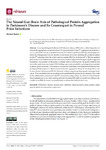The Neural Gut–Brain Axis of Pathological Protein Aggregation in Parkinson’s Disease and Its Counterpart in Peroral Prion Infections
Beekes, Michael
A neuropathological hallmark of Parkinson’s disease (PD) is the cerebral deposition of
abnormally aggregated α-synuclein (αSyn). PD-associated αSyn (αSynPD) aggregates are assumed to
act, in a prion-like manner, as proteinaceous nuclei (“seeds”) capable of self-templated propagation.
Braak and colleagues put forward the idea of a neural gut-brain axis mediating the centripetal spread
of αSynPD pathology from the enteric nervous system (ENS) to the brain in PD. This has sparked
great interest and initiated passionate discussions both in support of and opposing the suggested
hypothesis. A precedent for the spread of protein seeds or seeding from the gastro-intestinal (GI)
tract to the central nervous system (CNS) had been previously revealed for pathological prion protein
in peroral prion infections. This article scrutinizes the similarities and dissimilarities between the
pathophysiological spread of disease-associated protein aggregation along the neural gut–brain axis
in peroral prion infections and PD. On this basis, evidence supporting the proposed neural gut–brain
axis in PD is concluded to be not as robust as that established for peroral prion infections. New tools
for the ultrasensitive detection of αSynPD-associated seeding activity in archived or fresh human
tissue samples such as real-time quaking induced conversion (RT-QuIC) or protein misfolding cyclic
amplification (PMCA) assays can possibly help to address this deficit in the future.
Dateien zu dieser Publikation

